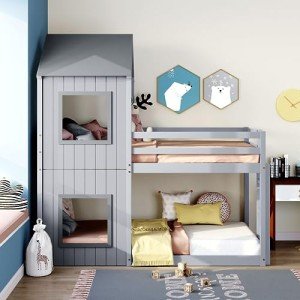20 Resources To Make You More Successful At Bunk Beds
Exploring Bunk Beds: A Comprehensive Guide
Bunk beds have long been a staple in children's bedrooms, dormitories, and even homes with limited space. Not only do they offer a practical sleeping option, but they likewise produce a fun and imaginative environment for kids and a great space-saver for adults and families. This short article will explore whatever you need to understand about bunk beds, from types and materials to security pointers and buying suggestions.
Tabulation
- Kinds Of Bunk Beds
- Standard Bunk Beds
- Loft Beds
- Triple Bunk Beds
- L-Shaped Bunk Beds
- Material Options
- Wood
- Metal
- Safety Considerations
- Purchasing Guide
- FAQs
Types of Bunk Beds
Bunk beds can be found in different designs to match various requirements and preferences. Here's a breakdown of the most common types:
Conventional Bunk Beds
Conventional bunks usually feature 2 beds stacked vertically on top of one another. These beds are ideal for brother or sisters sharing a room or for making the most of sleeping space in guest spaces.
Loft Beds
Loft beds stand likewise to conventional bunk beds however do not have a lower sleeping location. Instead, they typically incorporate a desk or seating location below, making them a great option for small spaces requiring multifunctionality.
Triple Bunk Beds
Triple bunk beds are created for 3 residents, with beds stacked in a three-tier configuration. These are less typical but can be a fun service for big households or slumber parties.
L-Shaped Bunk Beds
With one bed positioned horizontally and the other vertically, L-shaped bunk beds are often geared up with additional features such as desks or storage drawers and can complement corner spaces in a room.
Contrast of Bunk Bed Types
Bed Type
Ideal Use
Description
Conventional
Shared bed rooms or guest spaces
2 beds stacked vertically
Loft
Small rooms needing multi-purpose space
Upper bed with open space underneath
Triple
Big families or slumber parties
Three beds stacked vertically
L-Shaped
Corner or flexible spaces
A mix of vertical and horizontal beds
Material Options
Bunk beds are manufactured from numerous products, with wood and metal being the most typical. Each material has its advantages and disadvantages.
Wood
- Resilience: Generally robust and can hold up against years of use.
- Aesthetic Appeal: Offers a timeless appearance that can mix with different decors.
- Weight Capacity: Typically tougher; can support heavier weights.
- Disadvantages: May be more pricey than metal options and can be susceptible to scratches.
Metal
- Durability: Generally light-weight and simple to move however still durable.
- Modern Design: Often is available in smooth designs, making it appealing for contemporary areas.
- Cost-efficient: Usually less costly than wood options.
- Disadvantages: Can be cold to the touch in winters and might not have the very same visual appeal for some purchasers.
Safety Considerations
When it pertains to bunk beds, safety can not be neglected. Here are key security pointers to bear in mind:
- Guardrails: Ensure that the top bunk has guardrails on both sides to avoid falls.
- Tough Construction: Check for a solid construct and durable products to stand up to weight and movement.
- Weight Limit: Adhere to the producer's weight limit for both the upper and lower bunks.
- Ladder Design: Choose bunks with a safe, easy-to-climb ladder and avoid any sharp edges or rungs.
- Age Restrictions: Most manufacturers advise that children under the age of six need to not oversleep the upper bunk.
Buying Guide
When searching for bunk beds, think about the following elements to discover the best suitable for your needs:
- Space Availability: Measure the space size and ceiling height, guaranteeing there is appropriate space for the top bunk.
- Bed Size: Decide in between twin, complete, or larger sizes based on your requirements and the size of the room.
- Design Preference: Consider the overall design of the bed room to discover an appropriate design.
- Reduce of Setup: Look for a bunk bed that is straightforward to assemble.
- Budget plan: Bunk beds can be found in various cost varieties, so identify a spending plan before beginning your search.
Frequently asked questions
1. What is the recommended age for kids to sleep on the leading bunk?
Children aged six and older are normally recommended to sleep on the leading bunk to reduce the threat of falls.
2. How can I make my bunk bed much safer?
To boost security, make sure guardrails are appropriately installed and check that the bed is put on a flat surface. In addition, motivate kids to utilize the ladder carefully.
3. Can I transform a bunk bed into 2 separate beds?
Numerous bunk beds are created to be convertible. Inspect the producer's specs for convertibility functions.
4. What devices are offered for bunk beds?
Typical accessories include bed linens, storage drawers, staircases rather of ladders, and tented canopies for a fun visual appeal.
5. How do I maintain my bunk bed?
Routine look for loose screws or structural stability can help make sure security. Dust the bed frequently and clean spills immediately to keep the materials in good condition.
Bunk beds are versatile and a space-efficient service for numerous living situations, from kids's rooms to guest lodgings. With Bunkbeds For Sale of designs and materials readily available, possible buyers have a wealth of options to consider, ensuring a combination of functionality and visual appeals. By prioritizing safety and following the ideas outlined in this guide, people can discover the right bunk bed that suits their space and way of life, all while creating an enjoyable sleeping environment.
